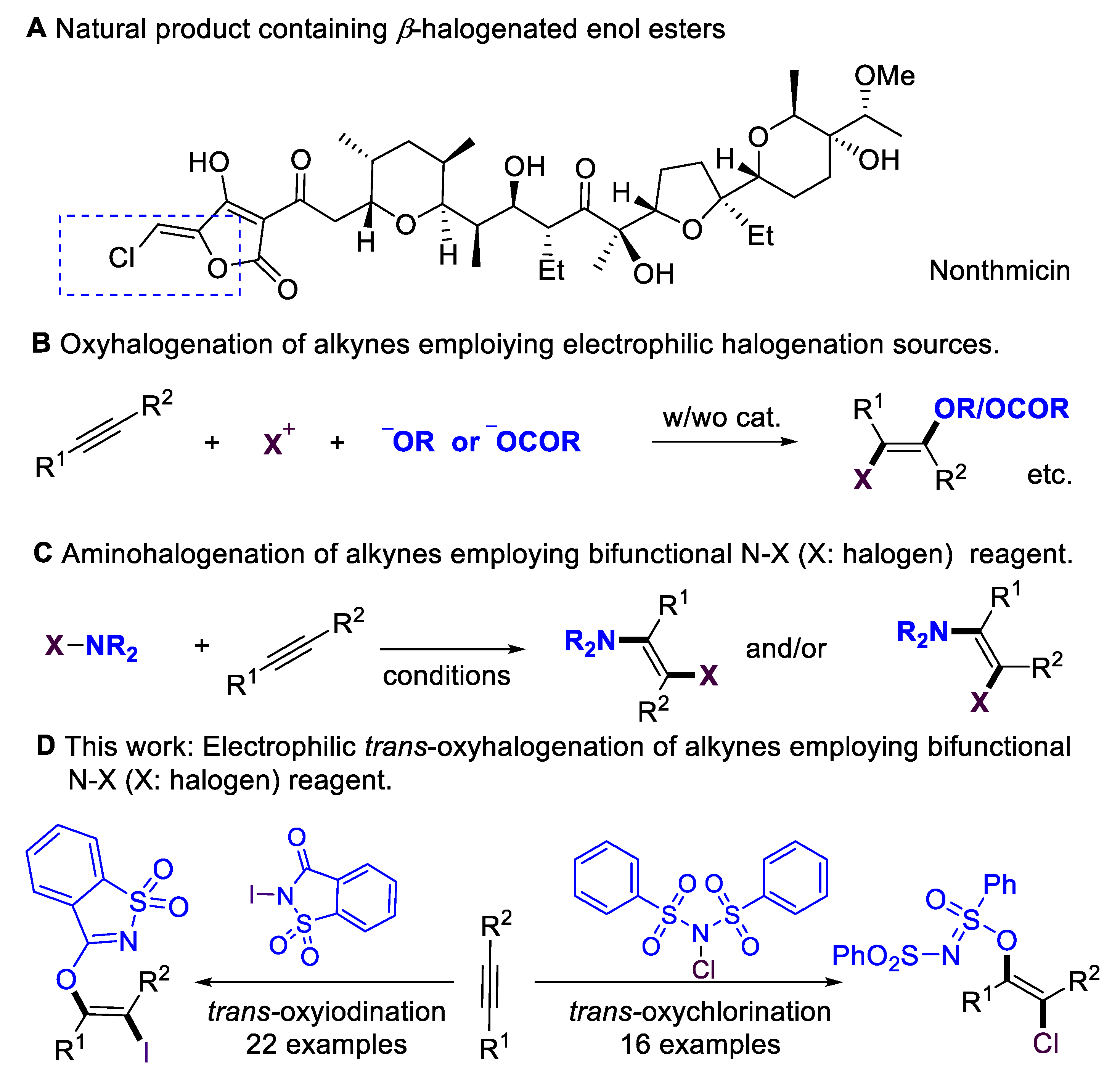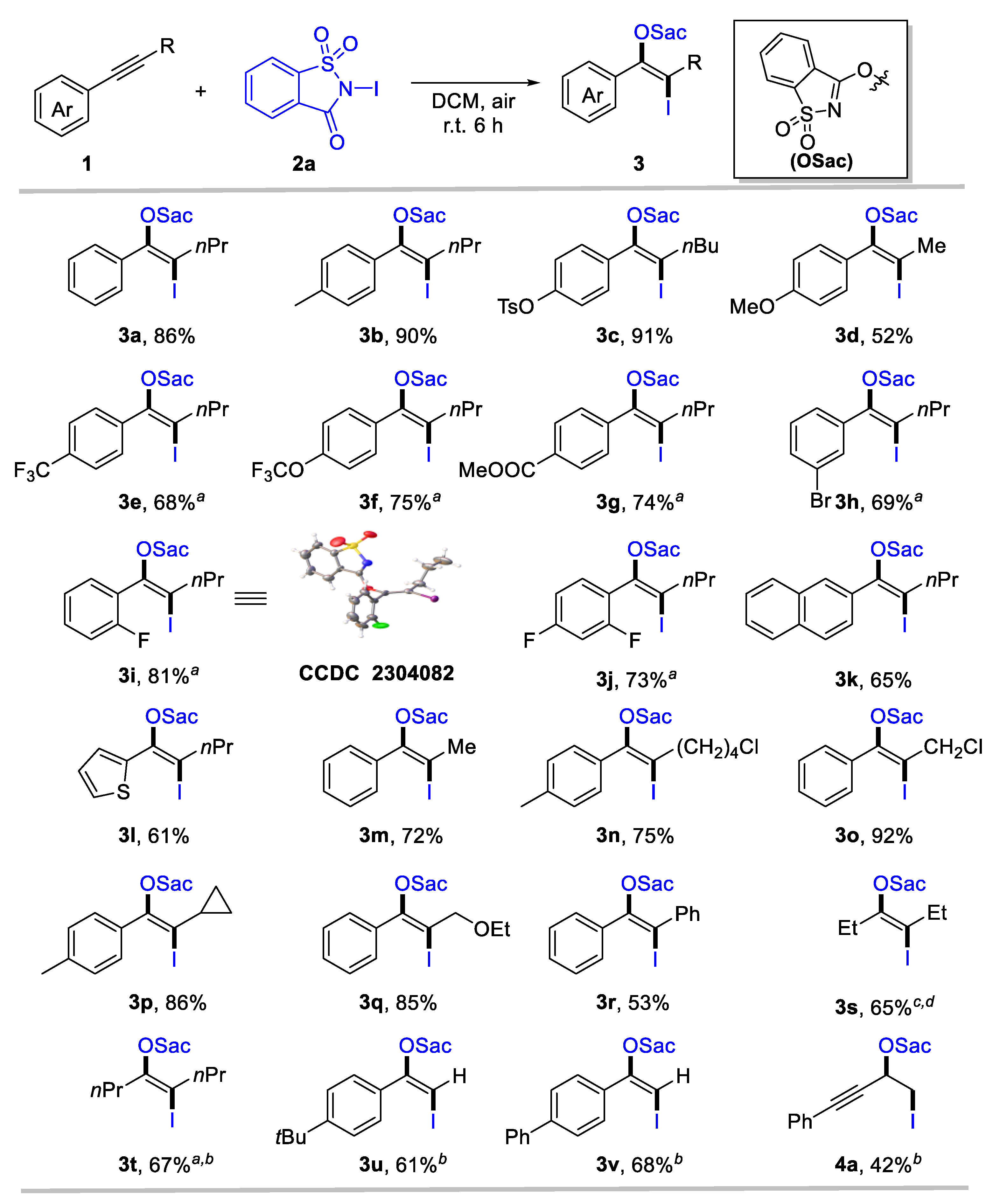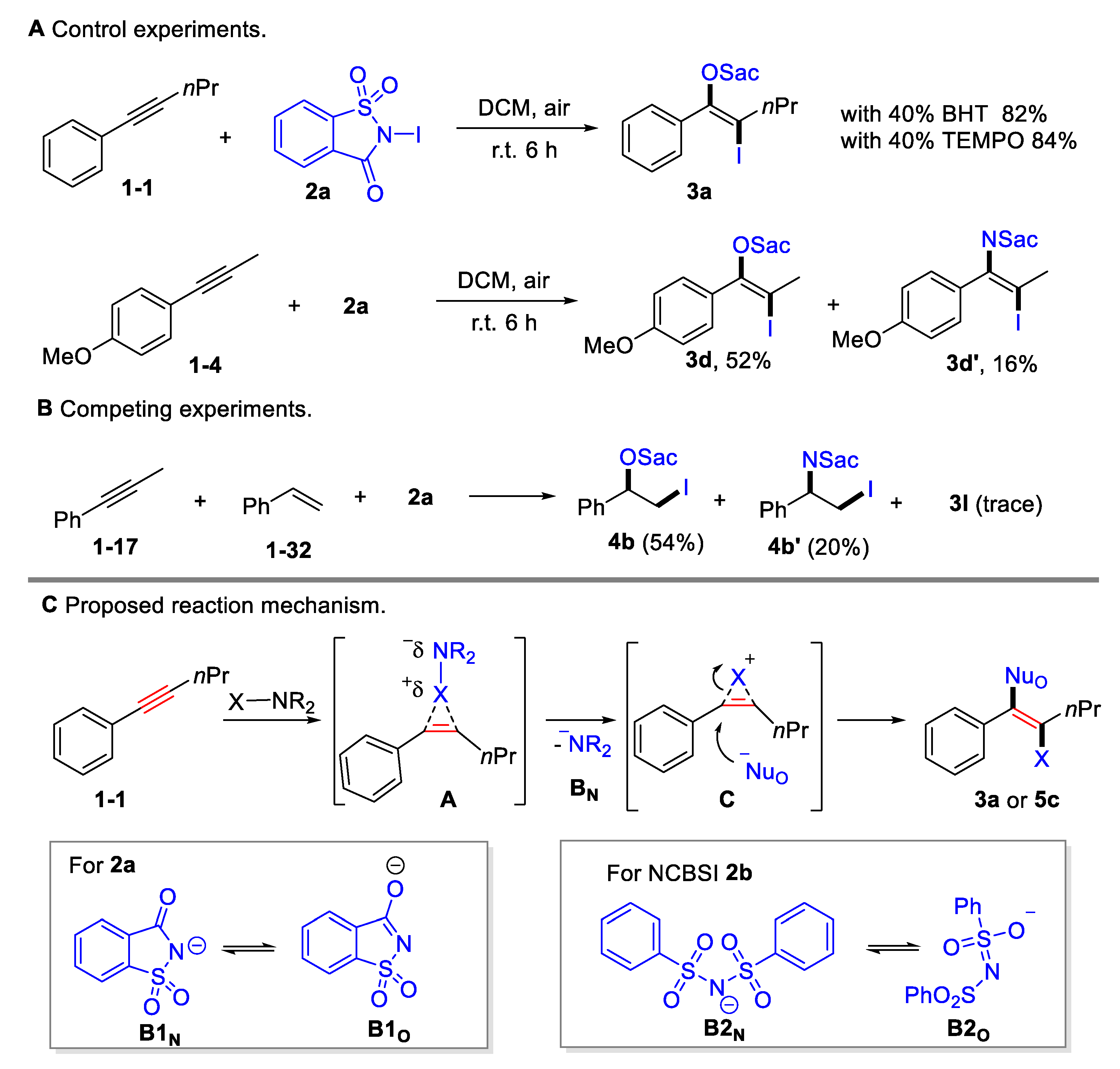Catalyst-Free Trans-Selective Oxyiodination and Oxychlorination of Alkynes Employing N–X (Halogen) Reagents
Abstract
:1. Introduction
2. Results and Discussions
3. Mechanistic Investigation
4. Materials and Methods
4.1. Materials and Instruments
4.2. The General Procedure for the Synthesis of 3
- (E)-3-((2-iodo-1-phenylpent-1-en-1-yl)oxy)benzo[d]isothiazole 1,1-dioxide 3a
- (E)-3-((2-iodo-1-(p-tolyl)pent-1-en-1-yl)oxy)benzo[d]isothiazole 1,1-dioxide 3b
- (E)-4-(1-((1,1-dioxidobenzo[d]isothiazol-3-yl)oxy)-2-iodohex-1-en-1-yl)phenyl 4-methylbenzenesulfonate 3c
- (E)-3-((2-iodo-1-(4-methoxyphenyl)prop-1-en-1-yl)oxy)benzo[d]isothiazole 1,1-dioxide 3d
- (E)-2-(2-iodo-1-(4-methoxyphenyl)prop-1-en-1-yl)benzo[d]isothiazol-3(2H)-one 1,1-dioxide 3d′
- (E)-3-((2-iodo-1-(4-(trifluoromethyl)phenyl)pent-1-en-1-yl)oxy)benzo[d]isothiazole 3e
- (E)-3-((2-iodo-1-(4-(trifluoromethoxy)phenyl)pent-1-en-1-yl)oxy)benzo[d]isothiazole 1,1-dioxide 3f
- methyl (E)-4-(1-((1,1-dioxidobenzo[d]isothiazol-3-yl)oxy)-2-iodopent-1-en-1-yl)benzoate 3g
- (E)-3-((1-(3-bromophenyl)-2-iodopent-1-en-1-yl)oxy)benzo[d]isothiazole 1,1-dioxide 3h
- (E)-3-((1-(2-fluorophenyl)-2-iodopent-1-en-1-yl)oxy)benzo[d]isothiazole 3i
- (E)-3-((1-(2,4-difluorophenyl)-2-iodopent-1-en-1-yl)oxy)benzo[d]isothiazole 1,1-dioxide 3j
- (E)-3-((2-iodo-1-(naphthalen-2-yl)pent-1-en-1-yl)oxy)benzo[d]isothiazole 1,1-dioxide 3k
- (E)-3-((2-iodo-1-(thiophen-2-yl)pent-1-en-1-yl)oxy)benzo[d]isothiazole 1,1-dioxide 3l
- (E)-3-((2-iodo-1-phenylprop-1-en-1-yl)oxy)benzo[d]isothiazole 1,1-dioxide 3m
- (E)-3-((6-chloro-2-iodo-1-(p-tolyl)hex-1-en-1-yl)oxy)benzo[d]isothiazole 1,1-dioxide 3n
- (E)-3-((3-chloro-2-iodo-1-phenylprop-1-en-1-yl)oxy)benzo[d]isothiazole 1,1-dioxide 3o
- (E)-3-((2-cyclopropyl-2-iodo-1-(p-tolyl)vinyl)oxy)benzo[d]isothiazole 1,1-dioxide 3p
- (E)-3-((3-ethoxy-2-iodo-1-phenylprop-1-en-1-yl)oxy)benzo[d]isothiazole 1,1-dioxide 3q
- (E)-3-((2-iodo-1,2-diphenylvinyl)oxy)benzo[d]isothiazole 1,1-dioxide 3r
- (E)-3-((4-iodohex-3-en-3-yl)oxy)benzo[d]isothiazole 1,1-dioxide 3s
- (E)-3-((5-iodooct-4-en-4-yl)oxy)benzo[d]isothiazole 1,1-dioxide 3t
- (E)-3-((1-(4-(tert-butyl)phenyl)-2-iodovinyl)oxy)benzo[d]isothiazole 1,1-dioxide 3u
- (E)-3-((1-([1,1′-biphenyl]-4-yl)-2-iodovinyl)oxy)benzo[d]isothiazole 1,1-dioxide 3v
- 3-((1-iodo-4-phenylbut-3-yn-2-yl)oxy)benzo[d]isothiazole 1,1-dioxide 4a
- 3-(2-iodo-1-phenylethoxy)benzo[d]isothiazole 1,1-dioxide 4b
- 2-(2-iodo-1-phenylethyl)benzo[d]isothiazol-3(2H)-one 1,1-dioxide 4b′
4.3. The General Procedure for the Synthesis of 5
- (E)-2-chloro-1-phenylprop-1-en-1-yl N-phenylsulfonylbenzenesulfonimidate 5a
- (E)-2-chloro-1-phenylbut-1-en-1-yl N-phenylsulfonylbenzenesulfonimidate 5b
- (E)-2-chloro-1-phenylpent-1-en-1-yl N-phenylsulfonylbenzenesulfonimidate 5c
- (E)-2-chloro-3,3-dimethyl-1-phenylbut-1-en-1-yl N-phenylsulfonylbenzenesulfonimidate 5d
- (E)-2-chloro-2-cyclopropyl-1-phenylvinyl N-phenylsulfonylbenzenesulfonimidate 5e
- (E)-2-chloro-2-cyclopropyl-1-(p-tolyl)vinyl N-(phenylsulfonyl)benzenesulfonimidate 5f
- (E)-2-chloro-1-phenylvinyl N-phenylsulfonylbenzenesulfonimidate 5g
- (E)-2-chloro-1-(p-tolyl)pent-1-en-1-yl N-phenylsulfonylbenzenesulfonimidate 5h
- (E)-1-([1,1′-biphenyl]-4-yl)-2-chloropent-1-en-1-yl N-phenylsulfonylbenzenesulfonimidate 5i
- (E)-2-chloro-1-(4-chlorophenyl)pent-1-en-1-yl N-phenylsulfonylbenzenesulfonimidate 5j
- (E)-2-chloro-1-(4-bromophenyl)pent-1-en-1-yl N-phenylsulfonylbenzenesulfonimidate 5k
- (E)-tert-butyl 4-(2-chloro-1-((N-(phenylsulfonyl)phenylsulfonimidoyl)oxy)pent-1-en-1-yl)benzoate 5l
- (E)-2-chloro-1-(4-(trifluoromethyl)phenyl)pent-1-en-1-yl N-phenylsulfonylbenzene sulfonimidate 5m
- (E)-2-chloro-1-(4-(trifluoromethoxy)phenyl)pent-1-en-1-yl N-phenylsulfonylbenzenesulfonimidate 5n
- (E)-1-(3-bromophenyl)-2-chloropent-1-en-1-yl N-phenylsulfonylbenzenesulfonimidate 5o
- (E)-2-chloro-1-(2-fluorophenyl)pent-1-en-1-yl N-phenylsulfonylbenzenesulfonimidate 5p
5. Conclusions
Supplementary Materials
Author Contributions
Funding
Institutional Review Board Statement
Informed Consent Statement
Data Availability Statement
Acknowledgments
Conflicts of Interest
References
- Takahashi, A.; Kirio, Y.; Sodeoka, M.; Sasai, H.; Shibasaki, M. Highly stereoselective synthesis of exocyclic tetrasubstituted enol ethers and olefins. A synthesis of nileprost. J. Am. Chem. Soc. 1989, 111, 643–647. [Google Scholar] [CrossRef]
- Lin, S.; Liu, H.; Svenningsen, E.B.; Wollesen, M.; Jacobsen, K.M.; Andersen, F.D.; Moyano-Villameriel, J.; Pedersen, C.N.; Nørby, P.; Tørring, T.; et al. Expanding the antibacterial selectivity of polyether ionophore antibiotics through diversity-focused semisynthesis. Nat. Chem. 2021, 13, 47–55. [Google Scholar] [CrossRef]
- Igarashi, Y.; Matsuoka, N.; In, Y.; Kataura, T.; Tashiro, E.; Saiki, I.; Sudoh, Y.; Duangmal, K.; Thamchaipenet, A. Nonthmicin, a Polyether Polyketide Bearing a Halogen-Modified Tetronate with Neuroprotective and Antiinvasive Activity from Actinomadura sp. Org. Lett. 2017, 19, 1406–1409. [Google Scholar] [CrossRef] [PubMed]
- Poulsen, T.B. Total Synthesis of Natural Products Containing Enamine or Enol Ether Derivatives. Acc. Chem. Res. 2021, 54, 1830–1842. [Google Scholar] [CrossRef]
- Fischer, P. Enol Ethers—Structure, Synthesis and Reactions. In Patai’s Chemistry of Functional Groups; Patai, S., Ed.; John Wiley & Sons: Chichester, UK, 1980; Volume 2, Chapter 17. [Google Scholar]
- Lempenauer, L.; Lemière, G.; Duñach, E. Cyclisation Reactions Involving Alkyl Enol Ethers. Adv. Synth. Catal. 2019, 361, 5284–5304. [Google Scholar] [CrossRef]
- Hansen, D.W., Jr.; Pappo, R.; Garland, R.B. A stereospecific total synthesis of the anthracyclinones (.+-.)-daunomycinone and (.+-.)-isodaunomycinone. J. Org. Chem. 1988, 53, 4244–4253. [Google Scholar] [CrossRef]
- Duan, H.; Sun, X.; Liao, W.; Petersen, J.L.; Shi, X. Proline as Lewis Base Catalyst: Diastereoselective Synthesis of Isoxazoline-N-oxide through [3 + 2] Cycloaddition. Org. Lett. 2008, 10, 4113–4116. [Google Scholar] [CrossRef]
- Tang, W.; Liu, D.; Zhang, X. Asymmetric Hydrogenation of Itaconic Acid and Enol Acetate Derivatives with the Rh-TangPhos Catalyst. Org. Lett. 2003, 5, 205–207. [Google Scholar] [CrossRef]
- Behenna, D.C.; Stoltz, B.M. The Enantioselective Tsuji Allylation. J. Am. Chem. Soc. 2004, 126, 15044–15045. [Google Scholar] [CrossRef]
- Trost, B.M.; Xu, J. Palladium-Catalyzed Asymmetric Allylic α-Alkylation of Acyclic Ketones. J. Am. Chem. Soc. 2005, 127, 17180–17181. [Google Scholar] [CrossRef]
- Barluenga, J.; Rodriguez, A.; Campos, P.J. Synthesis of 2-Functionalized 1,1-Diiodo-1 Alkenes. Generation and Reactions of 1-Iodo-1-Lithio-1 Alkenes and 1,1-Dilithio-1-Alkenes. J. Am. Chem. Soc. 1988, 110, 5567–5568. [Google Scholar] [CrossRef]
- Reppe, W. Vinylation. 1. Vinyl Ethers and Vinyl Esters. Liebigs Ann. Chem. 1956, 601, 84–111. [Google Scholar]
- Agarwal, V.; Miles, Z.D.; Winter, J.M.; Eustáquio, A.S.; El Gamal, A.A.; Moore, B.S. Enzymatic Halogenation and Dehalogenation Reactions: Pervasive and Mechanistically Diverse. Chem. Rev. 2017, 117, 5619–5674. [Google Scholar] [CrossRef] [PubMed]
- Varenikov, A.; Shapiro, E.; Gandelman, M. Decarboxylative Halogenation of Organic Compounds. Chem. Rev. 2021, 121, 412–484. [Google Scholar] [CrossRef] [PubMed]
- China, H.; Kumar, R.; Kikushima, K.; Dohi, T. Halogen-Induced Controllable Cyclizations as Diverse Heterocycle Synthetic Strategy. Molecules 2020, 25, 6007. [Google Scholar] [CrossRef]
- Dohi, T. Recent Topics in Organohalogen Reagents and Compounds. Curr. Org. Chem. 2020, 24, 2029–2030. [Google Scholar] [CrossRef]
- Shetgaonkar, S.E.; Jothish, S.; Dohi, T.; Singh, F.V. Iodine(V)-Based Oxidants in Oxidation Reactions. Molecules 2023, 28, 5250. [Google Scholar] [CrossRef]
- Song, S.; Li, X.; Wei, J.; Wang, W.; Zhang, Y.; Ai, L.; Zhu, Y.; Shi, X.; Zhang, X.; Jiao, N. DMSO-catalysed late-stage chlorination of (hetero)arenes. Nat. Catal. 2020, 3, 107–115. [Google Scholar] [CrossRef]
- Wang, W.; Yang, X.; Dai, R.; Yan, Z.; Wei, J.; Dou, X.; Qiu, X.; Zhang, H.; Wang, C.; Liu, Y.; et al. Catalytic Electrophilic Halogenation of Arenes with Electron-Withdrawing Substituents. J. Am. Chem. Soc. 2022, 144, 13415–13425. [Google Scholar] [CrossRef]
- Wang, W.; Wang, H.; Dai, R.; Wang, Y.; Li, Z.; Yang, X.; Lu, B.; Jiao, N.; Song, S. Organocatalytic Deoxyhalogenation of Alcohols with Inorganic Halides. ACS Catal. 2023, 13, 9033–9040. [Google Scholar] [CrossRef]
- Kutsumura, N.; Niwa, K.; Saito, T. Novel One-Pot Method for Chemoselective Bromination and Sequential Sonogashira Coupling. Org. Lett. 2010, 12, 3316. [Google Scholar] [CrossRef] [PubMed]
- Reiser, O. Palladium-Catalyzed Coupling Reactions for the Stereoselective Synthesis of Tri- and Tetrasubstituted Alkenes. Angew. Chem. Int. Ed. 2006, 45, 2838. [Google Scholar] [CrossRef] [PubMed]
- Takeda, Y.; Shimizu, M.; Hiyama, T. Straightforward Synthesis of CF3-Substituted Triarylethenes by Stereoselective Threefold Cross-Coupling Reactions. Angew. Chem. Int. Ed. 2007, 46, 8659. [Google Scholar] [CrossRef]
- Kitamura, T.; Furuki, R.; Taniguchi, H.; Stang, P.J. Electrophilic additions of iodosylbenzene activated by trifluoromethanesulfonic acid, [PhIO-TfOH], to alkynes. Tetrahedron 1992, 48, 7149–7156. [Google Scholar] [CrossRef]
- Muraki, T.; Togo, H.; Yokoyama, M. Reactivity and Synthetic Utility of 1-(Arenesulfonyloxy)benziodoxolones. J. Org. Chem. 1999, 64, 2883–2889. [Google Scholar] [CrossRef] [PubMed]
- Chen, Z.; Li, J.; Jiang, H.; Zhu, S.; Li, Y.; Qi, C. Silver-Catalyzed Difunctionalization of Terminal Alkynes: Highly Regio- and Stereoselective Synthesis of (Z)-β-Haloenol Acetates. Org. Lett. 2010, 12, 3262–3265. [Google Scholar] [CrossRef]
- Okamoto, N.; Miwa, Y.; Minami, H.; Takeda, K.; Yanada, R. Regio- and Stereoselective Multisubstituted Enol Ester Synthesis. J. Org. Chem. 2011, 76, 9133–9138. [Google Scholar] [CrossRef]
- Priebbenow, D.L.; Gable, R.W.; Baell, J. Regio- and Stereoselective Iodoacyloxylations of Alkynes. J. Org. Chem. 2015, 80, 4412–4418. [Google Scholar] [CrossRef]
- Ding, W.; Chai, J.; Wang, C.; Wu, J.; Yoshikai, N. Stereoselective Access to Highly Substituted Vinyl Ethers via trans-Difunctionalization of Alkynes with Alcohols and Iodine(III) Electrophile. J. Am. Chem. Soc. 2020, 142, 8619–8624. [Google Scholar] [CrossRef]
- Kikuchi, J.; Maesaki, K.; Sasaki, S.; Wang, W.; Ito, S.; Yoshikai, N. Stereoselective Synthesis of β-Alkoxy-β-amido Vinylbenziodoxoles via Iodo(III)etherification of Ynamides. Org. Lett. 2022, 24, 6914–6918. [Google Scholar] [CrossRef]
- Liu, M.; Sun, J.; Zhang, T.; Ding, Y.; Han, Y.-Q.; Martín-Montero, R.; Lan, Y.; Shi, B.-F.; Engle, K.M. Regio- and Stereoselective 1,2-Oxyhalogenation of Non-Conjugated Alkynes via Directed Nucleopalladation: Catalytic Access to Tetrasubstituted Alkenes**. Angew. Chem. Int. Ed. 2022, 61, e202209099. [Google Scholar] [CrossRef] [PubMed]
- Chemler, S.R.; Bovino, M.T. Catalytic Aminohalogenation of Alkenes and Alkynes. ACS Catal. 2013, 3, 1076–1091. [Google Scholar] [CrossRef] [PubMed]
- Wille, U.; Krüger, O.; Kirsch, A.; Lüning, U. Radical Addition of N-Bromophthalimide to Linear and Cyclic Alkynes. Eur. J. Org. Chem. 1999, 1999, 3185–3189. [Google Scholar] [CrossRef]
- Liu, X.-Y.; Gao, P.; Shen, Y.-W.; Liang, Y.-M. Copper-Catalyzed Chloroamination of Alkynes: Highly Regio- and Stereoselective Synthesis of (E)-β-Chloro-Enesulfonamides. Adv. Syn. Catal. 2011, 353, 3157–3160. [Google Scholar] [CrossRef]
- Li, M.; Yuan, H.; Zhao, B.; Liang, F.; Zhang, J. Alkyne aminohalogenation enabled by DBU-activated N-haloimides: Direct synthesis of halogenated enamines. Chem. Commun. 2014, 50, 2360–2363. [Google Scholar] [CrossRef] [PubMed]
- Dolenc, D. N-Iodosaccharin—A New Reagent for Iodination of Alkenes and Activated Aromatics. Synlett 2000, 2000, 544–546. [Google Scholar]
- Aloui, M.; Fairbanks, A.J. N-Iodosaccharin: A Potent New Activator of Thiophenylglycosides. Synlett 2001, 2001, 0797–0799. [Google Scholar] [CrossRef]
- Dolenc, D. Iodination of Enol Acetates and 1,3-Diones Using N-Iodosaccharin. Synth. Commun. 2003, 33, 2917–2924. [Google Scholar] [CrossRef]
- Bailey, L.; Handy, S.T. Aromatic iodination using N-iodosaccharin in room temperature ionic liquids. Tetrahedron Lett. 2011, 52, 2413–2414. [Google Scholar] [CrossRef]
- Cai, Y.; Liu, X.; Li, J.; Chen, W.; Wang, W.; Lin, L.; Feng, X. Asymmetric Iodoamination of Chalcones and 4-Aryl-4-oxobutenoates Catalyzed by a Complex Based on Scandium(III) and a N,N′-Dioxide Ligand. Chem. Eur. J. 2011, 17, 14916–14921. [Google Scholar] [CrossRef]
- Dutta, H.S.; Khan, B.; Khan, A.A.; Raziullah; Ahmad, A.; Kant, R.; Koley, D. Metal-Free, Oxidant-Free, Site-Selective C–H Halogenations to Aminoquinolines at Room Temperature using N-Halosaccharins. ChemistrySelect 2017, 2, 6488–6492. [Google Scholar] [CrossRef]
- Davis, F.A.; Towson, J.C.; Vashi, D.B.; ThimmaReddy, R.; McCauley, J.P., Jr.; Harakal, M.E.; Gosciniak, D.J. Chemistry of oxaziridines. 13. Synthesis, reactions, and properties of 3-substituted 1,2-benzisothiazole 1,1-dioxide oxides. J. Org. Chem. 1990, 55, 1254–1261. [Google Scholar] [CrossRef]
- Fukuzumi, T.; Bode, J.W. A Reagent for the Convenient, Solid-Phase Synthesis of N-Terminal Peptide Hydroxylamines for Chemoselective Ligations. J. Am. Chem. Soc. 2009, 131, 3864–3865. [Google Scholar] [CrossRef] [PubMed]
- Zheng, G.; Zhao, J.; Li, Z.; Zhang, Q.; Sun, J.; Sun, H.; Zhang, Q. Highly Regio- and Stereoselective Intermolecular Seleno- and Thioamination of Alkynes. Chem. Eur. J. 2016, 22, 3513–3518. [Google Scholar] [CrossRef] [PubMed]
- Wang, L.; Ma, R.; Sun, J.; Zheng, G.; Zhang, Q. NHC and visible light-mediated photoredox co-catalyzed 1,4-sulfonylacylation of 1,3-enynes for tetrasubstituted allenyl ketones. Chem. Sci. 2022, 13, 3169–3175. [Google Scholar] [CrossRef]
- Wang, L.; Ma, R.; Xia, J.; Liu, X.; Sun, J.; Zheng, G.; Zhang, Q. DBU-Mediated Isomerization/6-pi Electro-Cyclization/Oxidation Cascade of Sulfonyl-Substituted Allenyl Ketones for the Construction of Hetero-1,3,5-Trisubstituted Benzene. Chem. Eur. J. 2023, 29, e202203309. [Google Scholar] [CrossRef]
- Wang, L.; Sun, J.; Xia, J.; Li, M.; Zhang, L.; Ma, R.; Zheng, G.; Zhang, Q. Visible light-mediated NHCs and photoredox co-catalyzed radical 1,2-dicarbonylation of alkenes for 1,4-diketones. Sci. China Chem. 2022, 65, 1938–1944. [Google Scholar] [CrossRef]
- Wu, Y.; Li, M.; Sun, J.; Zheng, G.; Zhang, Q. Synthesis of Axially Chiral Aldehydes by N-Heterocyclic-Carbene-Catalyzed Desymmetrization Followed by Kinetic Resolution. Angew. Chem. Int. Ed. 2022, 61, e202117340. [Google Scholar] [CrossRef]
- Wang, L.; Sun, J.; Xia, J.; Ma, R.; Zheng, G.; Zhang, Q. Visible light-mediated NHC and photoredox co-catalyzed 1,2-sulfonylacylation of allenes via acyl and allyl radical cross-coupling. Org. Chem. Front. 2023, 10, 1047–1055. [Google Scholar] [CrossRef]
- Liang, T.; Wu, Y.; Sun, J.; Li, M.; Zhao, H.; Zhang, J.; Zheng, G.; Zhang, Q. Visible Light-Mediated Cobalt and Photoredox Dual-Catalyzed Asymmetric Reductive Coupling for Axially Chiral Secondary Alcohols. Chin. J. Chem. 2023, 41, 3253–3260. [Google Scholar] [CrossRef]
- Sun, J.; Wang, L.; Zheng, G.; Zhang, Q. Recent advances in three-component radical acylative difunctionalization of unsaturated carbon–carbon bonds. Org. Chem. Front. 2023, 10, 4488–4515. [Google Scholar] [CrossRef]
- Palav, A.; Misal, B.; Ganwir, P.; Badani, P.; Chaturbhuj, G. Rapid, chemoselective and mild oxidation protocol for alcohols and ethers with recyclable N-chloro-N-(phenylsulfonyl)benzenesulfonamide. Tetrahedron Lett. 2021, 73, 153094. [Google Scholar] [CrossRef]
- Palav, A.; Misal, B.; Chaturbhuj, G. NCBSI/KI: A Reagent System for Iodination of Aromatics through In Situ Generation of I-Cl. J. Org. Chem. 2021, 86, 12467–12474. [Google Scholar] [CrossRef] [PubMed]
- Misal, B.; Palav, A.; Ganwir, P.; Chaturbhuj, G. Activator free, expeditious and eco-friendly chlorination of activated arenes by N-chloro-N-(phenylsulfonyl)benzene sulfonamide (NCBSI). Tetrahedron Lett. 2021, 63, 152689. [Google Scholar] [CrossRef]




 | |||
|---|---|---|---|
| Entry | 2a | Solvent | Yield (%) a |
| 1 | 1.0 equiv | DCM | 68 |
| 2 | 1.2 equiv | DCM | 86 |
| 3 | 1.5 equiv | DCM | 85 |
| 4 | 1.2 equiv | CH3CN | 13 |
| 5 | 1.2 equiv | DCE | 80 |
| 6 | 1.2 equiv | Toluene | 45 |
| 7 | 1.2 equiv | PhCF3 | 74 |
| 8 | 1.2 equiv | MeOH | n.d. |
| 9 b | 1.2 equiv | DCM | 86 |
Disclaimer/Publisher’s Note: The statements, opinions and data contained in all publications are solely those of the individual author(s) and contributor(s) and not of MDPI and/or the editor(s). MDPI and/or the editor(s) disclaim responsibility for any injury to people or property resulting from any ideas, methods, instructions or products referred to in the content. |
© 2023 by the authors. Licensee MDPI, Basel, Switzerland. This article is an open access article distributed under the terms and conditions of the Creative Commons Attribution (CC BY) license (https://creativecommons.org/licenses/by/4.0/).
Share and Cite
Sun, J.; Guo, Y.; Xia, J.; Zheng, G.; Zhang, Q. Catalyst-Free Trans-Selective Oxyiodination and Oxychlorination of Alkynes Employing N–X (Halogen) Reagents. Molecules 2023, 28, 7420. https://doi.org/10.3390/molecules28217420
Sun J, Guo Y, Xia J, Zheng G, Zhang Q. Catalyst-Free Trans-Selective Oxyiodination and Oxychlorination of Alkynes Employing N–X (Halogen) Reagents. Molecules. 2023; 28(21):7420. https://doi.org/10.3390/molecules28217420
Chicago/Turabian StyleSun, Jiaqiong, Yunliang Guo, Jiuli Xia, Guangfan Zheng, and Qian Zhang. 2023. "Catalyst-Free Trans-Selective Oxyiodination and Oxychlorination of Alkynes Employing N–X (Halogen) Reagents" Molecules 28, no. 21: 7420. https://doi.org/10.3390/molecules28217420







